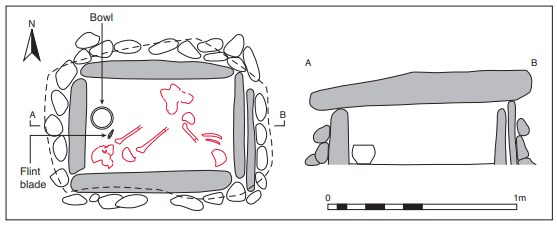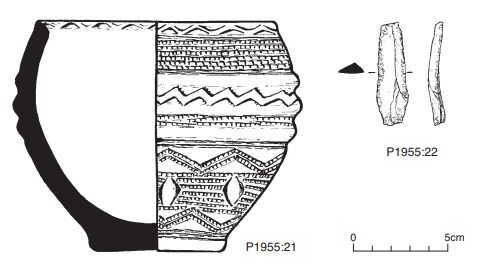County: Carlow Site name: VERMOUNT, CO. CARLOW
Sites and Monuments Record No.: SMR CW009-012 Licence number: E1037
Author: ELLEN PRENDERGAST
Site type: Early Bronze Age graves
Period/Dating: —
ITM: E 695849m, N 678388m
Latitude, Longitude (decimal degrees): 52.847888, -6.577033
Introduction
During work on his father’s farm in November 1955 near Hacketstown, Co. Carlow, Mr Denis Cullen discovered a short cist containing two inhumation burials, a flint blade and a ribbed bowl. The capstone of the cist was slanted, and therefore ‘almost at ground level’ at one side, while the other side is reported to have been ‘a few feet down’. Mr Cullen replaced the capstone and reported the find to the Garda Síochána, who reported it to the NMI. The site was investigated approximately a week after its discovery by Ellen Prendergast. As there is no site report on file, this report is based on the site drawings and photography, correspondence in the file and Professor C.A. Erskine’s anatomical report.
Location (Fig. 3.10)
The cist is in the townland of Vermont, north-east Co. Carlow, close to the border with County Wicklow.24 The burial lay at the highest point in the field, between c. 180m and 210m above sea level.

Description of site
The cist was rectangular in plan, with its long axis aligned east/west. Internally it measured 0.77m long by 0.47m wide by 0.31m deep. It was composed of five principal stones set on edge, with one each forming the northern, western and southern sides, and two thinner slabs

placed parallel to each other at the eastern end (Fig. 3.11). The side slabs were regular in form, with a maximum thickness of 0.12m, maximum height of 0.32m and a maximum length of 0.82m. All of the cist slabs were flanked externally by smaller packing stones; the entire cist was covered with a large flat capstone, which appears to have rested directly on the side stones. The packing stones had a maximum length of 0.18m and a maximum width of 0.09m. Owing to the fact that the eastern end was higher than the western, the capstone slanted slightly upwards from west to east.25 The capstone was very large and extended out beyond the northern, eastern and western sides of the cist, measuring 1.19m long by 0.86m wide by 0.18m thick (maximum dimensions). The floor of the cist does not appear to have been paved. The plan and section of the cist do not make any reference to a pit dug to receive the cist.
The cist contained two inhumation burials, both of adult females (P1955:23), at least one of which was crouched, accompanied by a ribbed bowl and a flint blade. One skull lay in the south-west corner of the cist, facing north. From the site plan, it appears that at least one of the bodies had been placed in a crouched position, on its left-hand side, but the bones seem to have been somewhat disturbed. The excavator was not aware that the cist contained the remains of two individuals, and there is no indication from the plan of a second burial. A ribbed bowl was placed mouth upwards just north of the skull at the centre point of the western wall of the cist, and the flint blade was found just south of this.
Ribbed bowl, P1955:21 (Fig. 3.12)
The first band of decoration occurs immediately below the rim and consists of a thin band (maximum width 7mm) of triangular impressions forming a zone of false relief. This band of decoration is mirrored on the inside of the vessel. On the outside of the bowl, this first zone of decoration is bounded by a thin, incised horizontal line. Below this are four rows of combimpressed horizontal lines. This band is bordered by two thin incised lines and below this by the first rib. Between this rib and the next is a row of incised chevron pattern. Below the second rib is a band of comb-impressed chevron decoration, which is formed of two parallel lines of comb impressions. Following this is the third and final rib. Below this rib are four parallel, horizontal incised lines. These lines are irregularly executed and sometimes converge into two lines. These lines border a horizontal band, c. 1.5cm thick, consisting of a chevron again formed of a double row of comb impressions. The next band of decoration consists of a series of about seven (sometimes less as they tend to converge) parallel horizontal lines punctuated every 2.5cm by an impressed diamond shape (measuring 8mm wide by 9mm high). Below this zone is a second band of chevron design, which is also formed of a double row of comb impressions. Between this band and the base is a row of about four thin, incised horizontal lines.

The base is undecorated. The vessel is a ribbed bowl as classified by Waddell (Ó Ríordáin and Waddell 1993). The fabric is light brown, with some grits measuring up to 9mm in length.
Dimensions: H 11.95cm; ext. D rim 12.6cm; D base 6.6cm; T at rim 0.6cm. Approximately one quarter of the vessel has been reconstructed.
Flint blade, P1955:22(Fig. 3.12)
This is a flake tool, smooth on the bulbar face. The striking platform is lozenge-shaped. Minute pressure flaking is visible on the long edges, beginning above the bulb and continuing right to the tip, where a single fracture gives a triangular-sectioned ‘nose’, oblique in relation to the sides. No secondary flaking is visible on the tip. Dimensions: L 5.3cm; max. W 1.1cm; max. T 0.5cm.
Comment
A sample of the human remains was submitted for AMS dating and yielded a date of 3575±40 BP, which calibrates to 2032–1775 BC.16 The ribbed bowl from Vermount has been assigned to stage 3 in the development of the bowl tradition by Brindley (2007, 247–8), which covers the period 1980 BC to 1930/20 BC.
HUMAN REMAINS
C.A. ERSKINE
The bones (P1955:23) comprise parts of two human skeletons. The parts are well preserved and appear to be contemporaneous. Though none of the long bones is complete, the skeletons are probably those of adult females of small build. The causes of death cannot be determined from the skeletons.
The skull fragments are mostly occipital and parietal bones. A crack in one occipital bone certainly occurred post-mortem. The general shape and curvature of these bones taken together indicate a modern cranial capacity of approximately 1,300–1,400cc, though an accurate measurement is not possible. There are not enough fragments to enable a reconstruction sufficient to offer an opinion as to the presence of brachycephaly or dolichocephaly. Parts of the facial skeleton, though fragmentary, are very well preserved. The mandibular fragments are rather small and light. The molar teeth preserved are fairly well worn; they do not present any definite divergence from those of modern man.
24. Parish of Clonmore, barony of Rathvilly. SMR CW009-012——. IGR 295920 178350. See also Brindley and Kilfeather 1993.
25. The eastern end stone stood 32cm above ground level, while that at the west was 29cm above ground level.
26. GrA-24158.